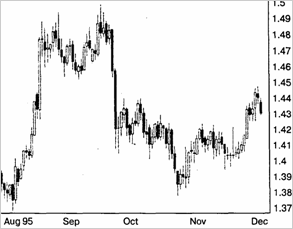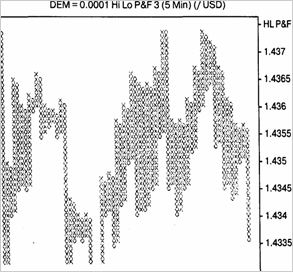
Point and Figure Charts
Point and Figure charts are a study of pure price movement with no indication of time or volume trading. This chart filters out insignificant price movements and plots only the rises and falls in market values. A column of "X" denotes rising prices and a column of'0's falling prices.
Later columns are displayed to the right of previous columns. X's are only added to a column ofX's if the high is at least one unit higher than the previous X displayed, 0's similarly are only added when the low is at least one unit below the previous 0 displayed. If the current column is a column ofXs, a reversal or a new column of Os will take place only if no new Xs are added to the current interval (that is only if the high price is not higher than the previous high) and the low is at least the reversal number of box sizes below the value represented by the last X displayed.
Point and Figure charts provide very strict rules on how to buy and sell:
'Point and Figure Chart — график крестиков и ноликов
to plot - отмечать
later columns — (последующие по времени колонки
э: reversal — перемена направления
Buy at the Break of a triple top.
Sell at the Break of a triple bottom. These charts are particularly useful in a trending market because they keep you in the market. However, in a ranging market, these charts chop you around. A Horizontal Count of the Xs or Os is used for showing a direct link between the width of congestion and the size of the break out from that congestion. For estimating the next high or
to chop around — путать
e to 'estimate — рассчитывать, оценивать
low target, after a consolidation phase you must take the largest (the most) Xs or Os in one horizontal line (usually near the middle). Multiply the number of boxes in this line by the size of the reversal, then add this number to the point where the break out occurs. The Vertical Count, the count from top to bottom, is a measure of volatility. One must measure the beginning of the break out to when congestion begins then. > multiply the number of boxes in this line by the reversal size and. >• add this to the point where the next break out occurs.
target
break out
to occur
— контрольная плановая цифра предполагаемая цена
— точка прорыва — случаться

Exercises
Ex. I. Put questions to the underlined words.Ex. 2. Read the text and translate it.
Ex. 3. Discuss the pros and cons of the bar types of charts.
